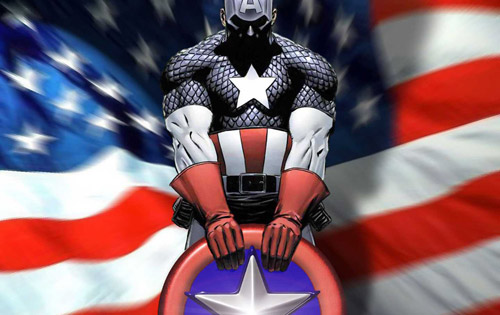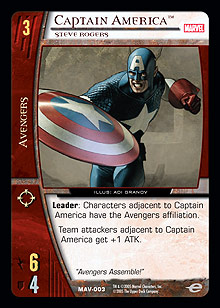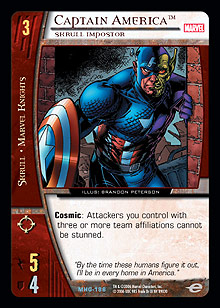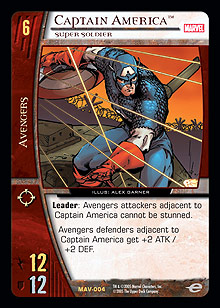We interrupt today’s scheduled programming to bring you shocking news: Captain America is dead. As shown in the pages of Captain America vol. 5, #25, the hero was shot repeatedly while being escorted into a federal courthouse to answer charges arising from the events of Civil War. Cap reportedly died in a nearby hospital shortly after as a result of those injuries.

I had originally intended to feature a different character in this week’s Living Ink, but such a shocking event warrants immediate coverage.
This article is being written on what can only be described as an international day of mourning. Today, news of Captain America’s death is being covered in mainstream media around the world, including CNN and the Associated Press. While the mainstream press stood up and took notice of the death of Superman in 1992, such attention is very rare and is a testament to the power of Captain America as an iconic figure in Western popular culture.
While Superman might be all about “truth, justice, and the American way,” Cap wears the Stars and Stripes right on his chest! Literally dressing yourself in the flag of a nation is a bold thing. In doing so, Cap casts himself as an avatar for a whole nation—and not just any nation, but the most powerful and influential country in the modern world. Spider-Man’s Uncle Ben taught him that “with great power comes great responsibility,” so stop for a moment to consider the extraordinary responsibility that Captain America shoulders whenever he puts on that uniform and picks up that shield.
What does Captain America mean to you? Every person will have a different answer to that question. Ed Brubaker, the writer of Captain America vol. 5, #25, highlighted this dynamic in a quote given to Newsarama: “What I found is that all the really hardcore left-wing fans want Cap to be standing out on and giving speeches on the street corner against the George W. Bush administration, and all the really right-wing fans all want him to be over in the streets of Baghdad, punching out Saddam Hussein.”
While I consider myself 100% Australian (having lived here for more than two-thirds of my life), I was born in the USA, so hopefully my personal perspective will land somewhere between the extremes of blind patriotism and excessive cynicism. No one wants to read an overly-patriotic rant, and I’m a firm believer that you should never speak ill of the dead. I promise to neither canonize nor vilify the fallen Captain.
To me, Captain America represents all of the best things about America. While it has been suggested that Captain America, like DC’s Superman, has become yesterday’s hero, I believe the values he stands for are as important and relevant today as in the past—if not more so. He is a beacon of hope when such a commodity seems scarce in the world around us. Co-creator Joe Simon, quoted by the AP following the breaking news of Cap’s death, rightfully stated, "We really need him now.”
Captain America possesses a true commitment to liberty and freedom, free of personal ambition and pursuit of glory. As far from a puppet of the U.S. Government as you can get, Cap calls things as they are and has repeatedly shown a willingness to stand against official and popular opinion when the aforementioned values are jeopardized. Civil War is just one of countless examples of Cap’s willingness to oppose the system.
Cap has never been the strongest, smartest, fastest, or most powerful hero, yet prior to Civil War there wasn’t a hero in the Marvel Universe who didn’t defer to him whenever the fate of the world was on the line. That respect comes as a direct result of the qualities of Cap’s actions and has nothing to do with the star on his chest. It’s easy to spout rhetoric about freedom and justice, but it’s another thing to back it up with action and put those values ahead of any personal interest.
Perhaps some readers are not as familiar with Captain America as those of us who regularly immerse ourselves in the four-color worlds of comic book fantasy. Never fear; Living Ink is here to give you a crash course on all things Captain America and explain to you why you should be at least halfway through the five stages of grief following his untimely death.
Captain America was created by writer Joe Simon and artist extraordinaire Jack Kirby (a name that sits very near the top in any list of comic book royalty) in March 1941. Our hero first appeared in Timely Comics’ Captain America Comics #1.
Keen observers among you will have noticed that I wrote Timely Comics, not Marvel Comics. The company was originally founded in 1939 as Timely Comics and was generally known as Atlas Comics during the 1950s. It didn’t become Marvel Comics until the early 1960s, when the Fantastic Four and other super hero titles created by Stan Lee, Jack Kirby, and Steve Ditko were launched.
We can see that the birth of Captain America very closely coincides with the birth of Marvel Comics (before it was even called Marvel). Cap was one of the most popular of Timely Comics’ Golden Age heroes, which included a number of patriotically-themed characters who fought the Nazis and Japanese during World War II. Following the end of the war, however, super heroes dipped in popularity, and Captain America Comics (which had been retitled Captain America's Weird Tales) was cancelled in 1950 after #75. He was briefly revived in some appearances alongside the Golden Age Human Torch (a fiery android, not to be confused with Johnny Storm of the Fantastic Four), but poor sales saw Cap shelved again around 1954.
Captain America’s final, triumphant return came in March 1964 in the pages of The Avengers #4 (see Earth’s Mightiest Heroes). This story explained that in the final days of World War II, Cap fell from a plane into the North Atlantic Ocean and spent decades frozen in a state of suspended animation. Revived, Captain America joined the Avengers and quickly took a leading role. Quickly embraced by a new generation of fans who seemingly couldn’t get enough of the once-terminal super hero genre, Captain America also stepped back into the spotlight as a solo hero in Tales of Suspense #59 (November 1964), half of which featured Cap, the other half of which focused on Iron Man. Tales of Suspense was retitled Captain America (considered vol. 1 for historical purposes) with issue #100, while Iron Man got a solo title of his own. The title was relaunched four times following that (including the 13-issue vol. 2 run, which was part of the Heroes Reborn story arc), with the current vol. 5 starting in January 2005. Marvel has publicly stated that this series will continue.

Technically, Cap isn’t super-powered; rather, he is as intelligent, strong, fast, agile, and durable as possible for a human being. He has been seen to bench press about a ton unassisted and can run a mile in just over a minute. Enhanced metabolic functions prevent the build-up of fatigue poisons in Captain America’s muscles, giving him endurance far in excess of an ordinary human being. He is unable to become intoxicated by alcohol and is immune to many diseases. Other than his physical prowess, Cap’s only weapon is his trusty shield, an indestructible discus-shaped piece of equipment made from a fusion of vibranium with an experimental steel alloy. This alloy was created by accident and never duplicated, although efforts to reverse-engineer it resulted in the creation of adamantium, the unbreakable metal that famously coats Wolverine’s claws and skeleton. Captain America originally carried a sidearm, but he soon found that throwing his shield was at least equally effective and far more efficient, so the gun was quickly abandoned.
In terms of character biography, Captain America’s alter-ego is Steve Rogers. Rogers was—naturally—born on the 4th of July in 1917, the son of Irish immigrants. At the start of World War II, Rogers tried to enlist in order to fight the Nazis but was rejected because he was too scrawny and weak. This all changed, however, when he was recruited into Operation: Rebirth, a top-secret military program that aimed to created Super Soldiers. Steve successfully passed the selection process and was injected with the Super-Soldier serum. Transformed, Rogers’s physical form was optimized. His musculature and reflexes were highly enhanced, and he was described as a “nearly perfect human being.”
Before anyone else could be given the Super-Soldier serum, however, a Nazi spy killed the serum’s inventor, and all of the secret ingredients and manufacturing processes were lost forever. Looking to maximize the value of its sole Super Soldier, the U.S. Government gave Rogers the identity of Captain America and put him to work as a field agent and effective propaganda vehicle.
Captain America was assisted by a teenage sidekick named Bucky Barnes and led a super-powered group called the Invaders, which included the Sub-Mariner and the original Human Torch. In 1945, during the closing days of World War II, Captain America and Bucky tried to stop the villainous Heinrich Zemo ◊ Baron Zemo from destroying an experimental drone plane. Zemo launched the plane with an armed explosive on it. Cap and Barnes reached the plane just before it took off, but when Bucky tried to defuse the bomb, it exploded in midair (see Hero’s Demise). Bucky was believed killed, and Cap was frozen in the icy waters of the North Atlantic. A series of successors took up the mantle of Captain America after Rogers’s apparent death, but the original Cap was reinstated after the Avengers discovered his frozen body in The Avengers #4.
Cap was racked with guilt over the “preventable” death of Bucky and, despite briefly allowing Rick Jones to assume the Bucky mantle, was resistant to the notion of having a sidekick. He later met and trained Sam Wilson, who became the Falcon. The two shared a close friendship and were partners in many heroic adventures.
Demonstrating Captain America’s commitment to his values and ideals, the character briefly abandoned his identity in response to the Marvel equivalent of the Watergate scandal and established the new persona Nomad. Rogers reassumed the mantle of Captain America some time later, realizing that the identity could be a symbol of American ideals without necessarily being representative of the U.S. government.
Years later, Rogers was given a large back-pay reimbursement dating back to his disappearance at the end of World War II, and a government commission ordered him to once again work directly for the U.S. government. Again he resigned his identity rather than compromise his ideals, becoming “The Captain.” The replacement Captain America, John Walker, tried to emulate Rogers's ideals until pressure from hidden enemies drove him insane. Steve then returned to the Captain America identity, while a recovered Walker became the U.S. Agent.
In recent comic book continuity, Cap discovered that Bucky survived the 1945 plane explosion, only to be rescued and later brainwashed by Russian operatives. The former sidekick became the deadly Winter Soldier. The Winter Soldier went on covert missions through the years, becoming increasingly ruthless and efficient as he killed in the name of the USSR. He was kept in stasis when not on missions and as a result only aged a few years since 1945. In Captain America vol. 5, #14, Captain America fought the Winter Soldier and tried to make him remember his past as Bucky. Eventually, Cap used the Cosmic Cube to make Bucky remember who he was. Regaining all his memories, the Winter Soldier was overcome with guilt and suffered a breakdown. Just prior to Captain America’s death, Barnes was conspiring with Nick Fury to help Rogers escape from custody.
This leads us to the recent events depicted in Marvel’s Civil War storyline. Captain America opposed mandatory registration of all super-powered beings and led the Anti-Registration faction and resistance movement, forming the “Secret Avengers.” At the climax of a battle between the two sides of the issue, Cap realized that his fight was endangering civilians. He surrendered and ordered his forces to stand down. This brings us to the events described at the top of this article, including the apparent assassination of our hero.
There are technically four versions of Captain America in Vs. System, but not all are quite as they seem.
 Captain America, Steve Rogers is a 3-drop from the Avengers expansion. The combination of his lower recruit cost and simple alter ego version suggests that this is Cap somewhat earlier in his career. Considering that the card “stacks” with the Iron Man, Tony Stark character card, I would suggest that chronologically this version of Cap exists shortly after the Avengers revived him in Avengers #4. At this stage Cap is already an accomplished hero, but I think it would be fair to say that he is still relatively new to his role as a leader of super heroes. Steve Rogers’s leader power makes adjacent characters into Avengers, which shows that he is a character who commands respect, and someone other heroes are quick to follow. Similarly, his status as a master strategist is represented by the card’s other power, which gives adjacent team attackers an ATK boost. Finally, Cap’s above-curve 6 ATK demonstrates his own fighting prowess, as few 3-drops are equal to or stronger than him in terms of combat potential. Steve Rogers is a flavorful card and does a great job of representing Captain America as an inspirational hero, strategic mastermind, and almost unparalleled hand-to-hand combatant.
Captain America, Steve Rogers is a 3-drop from the Avengers expansion. The combination of his lower recruit cost and simple alter ego version suggests that this is Cap somewhat earlier in his career. Considering that the card “stacks” with the Iron Man, Tony Stark character card, I would suggest that chronologically this version of Cap exists shortly after the Avengers revived him in Avengers #4. At this stage Cap is already an accomplished hero, but I think it would be fair to say that he is still relatively new to his role as a leader of super heroes. Steve Rogers’s leader power makes adjacent characters into Avengers, which shows that he is a character who commands respect, and someone other heroes are quick to follow. Similarly, his status as a master strategist is represented by the card’s other power, which gives adjacent team attackers an ATK boost. Finally, Cap’s above-curve 6 ATK demonstrates his own fighting prowess, as few 3-drops are equal to or stronger than him in terms of combat potential. Steve Rogers is a flavorful card and does a great job of representing Captain America as an inspirational hero, strategic mastermind, and almost unparalleled hand-to-hand combatant.
 Captain America, Skrull Impostor is another 3-drop version of Cap (this one from the Heralds of Galactus expansion), but whenever shape-changing Skrulls are involved, appearances can be deceiving. What better way to destabilize your enemies and wreak chaos than to assume the identity of their most trusted hero? That’s pretty much what one Skrull thought, at any rate. Having been stranded on Earth, this Skrull infiltrated HYDRA and quickly ascended to the position of Supreme Hydra. Figuring that this title failed to capture his personal flair, he declared himself the Sensational Hydra. His scheme involved bolstering Captain America’s public image to even greater levels before capturing the hero and assuming his identity in Captain America vol. 3, #5. As Cap, the Sensational Skrull announced to the world that one in twenty Americans was in fact a Skrullian spy! He incited a nationwide witch hunt (or, rather, Skrull hunt) that led to unprecedented violence. Luckily, the real Captain America escaped his incarceration and publicly exposed the Skrull Cap as a fraud. As for the card, thankfully this Skrull impostor isn’t as good a fighter as Steve Rogers, but he’s clearly a lot sneakier. The more teams he and his Skrull teammates can insinuate themselves with, the more devastating their attacks; this character allows them to attack with wild abandon,
Captain America, Skrull Impostor is another 3-drop version of Cap (this one from the Heralds of Galactus expansion), but whenever shape-changing Skrulls are involved, appearances can be deceiving. What better way to destabilize your enemies and wreak chaos than to assume the identity of their most trusted hero? That’s pretty much what one Skrull thought, at any rate. Having been stranded on Earth, this Skrull infiltrated HYDRA and quickly ascended to the position of Supreme Hydra. Figuring that this title failed to capture his personal flair, he declared himself the Sensational Hydra. His scheme involved bolstering Captain America’s public image to even greater levels before capturing the hero and assuming his identity in Captain America vol. 3, #5. As Cap, the Sensational Skrull announced to the world that one in twenty Americans was in fact a Skrullian spy! He incited a nationwide witch hunt (or, rather, Skrull hunt) that led to unprecedented violence. Luckily, the real Captain America escaped his incarceration and publicly exposed the Skrull Cap as a fraud. As for the card, thankfully this Skrull impostor isn’t as good a fighter as Steve Rogers, but he’s clearly a lot sneakier. The more teams he and his Skrull teammates can insinuate themselves with, the more devastating their attacks; this character allows them to attack with wild abandon,  knowing that they can’t be stunned back. Recently I read a post on VSRealms.com that I really fell in love with. It argued that any toolbox deck that spurns team cohesion for greater power and broader synergy, and sports more affiliations than you can count, is actually a Skrull deck! I couldn’t find the post again to give proper acknowledgement, so I apologize to the original thinker that came up with it. I loved the simple eloquence of the idea.
knowing that they can’t be stunned back. Recently I read a post on VSRealms.com that I really fell in love with. It argued that any toolbox deck that spurns team cohesion for greater power and broader synergy, and sports more affiliations than you can count, is actually a Skrull deck! I couldn’t find the post again to give proper acknowledgement, so I apologize to the original thinker that came up with it. I loved the simple eloquence of the idea.
Captain America, Super Soldier is the 6-drop version of the character from the Avengers set. Like Steve Rogers, Super Soldier reflects Captain America’s outstanding leadership skills and tactical mind through a combat-oriented leader power. Adjacent teammates can attack without fear of being stunned, and are greatly enhanced on defense. In a way this makes Cap a big target for his enemies, which is just the way the comic book character would want it. Alex Garner’s artwork on this card is, in my opinion, a great representation of the character too, showing him cool and collected under fire and ready to biff the opposition with his shield.
 Captain America, Heroic Paragon is a 7-drop dual-affiliated character from the new Marvel Team-Up set. On this card, we see Cap lending Spider-Man a hand and, more importantly, encouraging his teammates to follow his lead and benefit from the protection of his nigh-indestructible shield. This Cap’s payment power allows him to use said shield to help protect any of your characters. I like the idea of Captain America being ready, willing, and able to leap to his teammates’ defense in combat, with a vow that “No man gets left behind!”
Captain America, Heroic Paragon is a 7-drop dual-affiliated character from the new Marvel Team-Up set. On this card, we see Cap lending Spider-Man a hand and, more importantly, encouraging his teammates to follow his lead and benefit from the protection of his nigh-indestructible shield. This Cap’s payment power allows him to use said shield to help protect any of your characters. I like the idea of Captain America being ready, willing, and able to leap to his teammates’ defense in combat, with a vow that “No man gets left behind!”
Last but not least, the following is a quick recommended reading list to further your enjoyment of Captain America’s adventures.
· Tales of Suspense #59-99 and Captain America #100-102 (1964-1968) – Republished in Essential Captain America, Vol. 1.
- Captain America: Red, White, & Blue TPB (2002) – Original stories as well as reprints of Tales of Suspense #55; Captain America vol. 1, #111; Marvel Fanfare #18; and Captain America vol. 4, #1.
· Civil War (2006-2007) – This story has only recently concluded, with The Road to Civil War TPB the first collected edition available.
· Captain America vol. 5, #1-9 and #11-14 (2005-2006) – Republished in Captain America: Winter Soldier, Vol. 1 and Captain America: Winter Soldier, Vol. 2.
· Captain America vol. 3, #3-7 (1998) – Sensational Hydra, Skrull Impostor.
· New Avengers #1-6 (2004-2005) – Republished in New Avengers Vol. 1: Breakout TPB.
· Ultimates #1-12 and Ultimates 2 #1-6 (2002-2006) – Republished in Ultimates Vol. 1: Super-Human, Ultimates Vol. 2: Homeland Security, and Ultimates 2 Vol. 1: Gods and Monsters.
R.I.P. Captain America.
See you in the funny pages,
Michael Pittman
ikeebear@hotmail.com